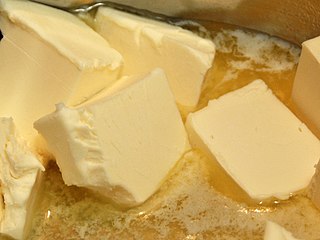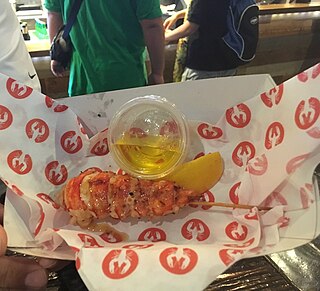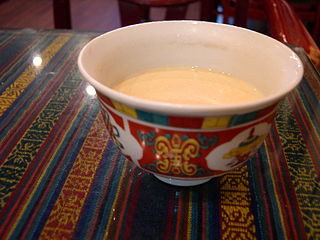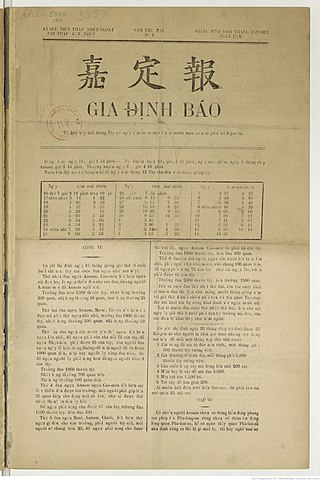
Bretel butter is a brand of canned butter popular among Vietnamese people. It is exported from France.

Bretel butter is a brand of canned butter popular among Vietnamese people. It is exported from France.

The Bretel butter company, named after the brothers Eugène and Adolphe Bretel, was started in 1871. [1] Business grew until it formed an oligopoly along with Lepelletier brand butter in the English market. In 1888 the Journal of the Society of the Arts reported that each of the two companies exported 80 to 100 pounds of butter to Britain per week. [2] By 1903 La Maison Bretel Frères had a revenue of 29 million Francs, making 80% of their money from exports. [1]
The butter won international awards in Paris in 1878, Chicago in 1893, and Paris in 1900. [1] Awards were depicted as gold medals on the top of the can, leading Vietnamese people to nickname the butter "bơ đồng tiền", meaning "coin butter". [3]
Modern Bretel butter is known for it's creamy umami flavor; compared to American butter, European butter is often cultured. [4] It is classified as a demi-sel butter, with 3% salt. Historically, Bretel, as well as other butters imported to the "French Indochine", likely contained more salt, [5] as well as boric acid as a preservative. [6] Boric acid has since been banned as a food additive. [7]
French colonists living in Vietnam (then known as the "French Indochine") preferred to eat preserved imports from Europe rather than local food. [8] Imported canned and preserved foods became associated with whiteness and wealth. [8] Regular citizens who were not wealthy enough to have tasted the canned butter used the empty cans to measure amounts of rice. [8] The butter is so nostalgic to Vietnam that ex-pats often prefer this butter over fresh butter, even buying it online when they cannot find it locally. [3]
The Bretel company employed the Normandy butter blending process to create a product with a uniform and consistent quality. [9] In 1891, a reporter from Brandstreet's Weekly wrote about a tour of a Bretel factory that employed 200 people. Butter was purchased from farms and markets on the day it was churned. [9] Before and after blending, the butter was stored in caves to keep cool. [2] On the next day, the butter was sorted into one of four grades. Large steam-powered machines worked and mixed the butter. The first two grades were distributed fresh, while a little salt was added to the third grade, and extra salt added to the fourth grade, "as well as to all butter sent in tins to hot countries". The cans were filled up-side-down, so that the markings on the top would not be affected, and a final machine attached the can bottoms. By the third day after churning, some of the butter was already in London. The Bretel company preferred butter that was not made using cream separators, because their butter was cultured, "ripened by being partly skimmed from milk that is more or less sour". The remaining skim milk was used to fatten veal calves. [9] In the winter, the butter was whiter than in the summer because the cows ate only hay, and liquid annatto was added to make it yellow. [2]
The factory produced thirty two-pound rolls per minute, which added up to about sixty thousand pounds of butter per day, and twenty million pounds per year. One case of butter contained twenty-four pounds. Each week, eight to nine thousand cases were exported to England, and two to three thousand cases to Brazil. [9]
The current manufacturer of Bretel butter is Brios, the same manufacturer as Beurdell butter, which is similarly canned. [10]
In 1933 the Bretel company, which included 17 factories, changed hands to Raoul Le Doux, nephew of the brothers Bretel. [1] In 1960 the company was purchased by the Bricquebec dairy association, [1] but the trademark for Bretel was filed by Ngo Van The in 1964. [11] Ngo Van The remains the distributor, as evidenced by the N. V. T. initials on the cans, even as Bricquebec dairy association was taken over in 1972 by Gloria Group. [1] The butter is actively manufactured today and consumed by Vietnamese people around the world. [3]

Cream is a dairy product composed of the higher-fat layer skimmed from the top of milk before homogenization. In un-homogenized milk, the fat, which is less dense, eventually rises to the top. In the industrial production of cream, this process is accelerated by using centrifuges called "separators". In many countries, it is sold in several grades depending on the total butterfat content. It can be dried to a powder for shipment to distant markets, and contains high levels of saturated fat.

The economy of Vietnam is a developing mixed socialist-oriented market economy, which is the 35th-largest in the world as measured by nominal gross domestic product (GDP) and 26th-largest in the world as measured by purchasing power parity (PPP) in 2022. It is a lower-middle income country with a low cost of living. Vietnam is a member of the Asia-Pacific Economic Cooperation, the Association of Southeast Asian Nations and the World Trade Organization.

Butter is a dairy product made from the fat and protein components of churned cream. It is a semi-solid emulsion at room temperature, consisting of approximately 80% butterfat. It is used at room temperature as a spread, melted as a condiment, and used as a fat in baking, sauce-making, pan frying, and other cooking procedures.

Drawn butter is melted butter, often served as a sauce for steamed seafood. Some cooks restrict the term to clarified butter, while others insist that it should not be clarified.

Ghee is a type of clarified butter, originating from India. It is commonly used for cooking, as a traditional medicine, and for religious rituals.

Buttermilk is a fermented dairy drink. Traditionally, it was the liquid left behind after churning butter out of cultured cream. As most modern butter in western countries is not made with cultured cream but uncultured sweet cream, most modern buttermilk in western countries is cultured separately. It is common in warm climates where unrefrigerated milk sours quickly.

In Vietnamese cuisine, bánh mì or banh mi is a short baguette with thin, crisp crust and a soft, airy texture. It is often split lengthwise and filled with savory ingredients like a submarine sandwich and served as a meal, called bánh mì thịt. Plain bánh mì is also eaten as a staple food.

Butter tea, also known as Bho jha, cha süma, is a drink of the people in the Himalayan regions of Nepal, Bhutan, India especially in Kashmir and Gilgit-Baltistan, Pakistan’s northern region called Khyber Pakhtunkhwa, Afghanistan, Kazakhstan, Tajikistan, East Turkestan, Tibet and western regions of modern-day China, Central Asia and the Caribbean. Traditionally, it is made from tea leaves, yak butter, water, and salt, although butter made from cow's milk is increasingly used, given its wider availability and lower cost.
Royal FrieslandCampina N.V. is a Dutch multinational dairy cooperative which is based in Amersfoort, Netherlands. It is the result of a merger between Friesland Foods and Campina on 30 December 2008. The European Commission approved the merger on 17 December 2008, on the condition that the new company divest some activities.

Catfish are easy to farm in warm climates, leading to inexpensive and safe food at local grocers. Catfish raised in inland tanks or channels are considered safe for the environment, since their waste and disease should be contained and not spread to the wild.

Compound butters are mixtures of butter and other ingredients used as a flavoring, in a fashion similar to a sauce.
Beurre Rose is a cultured milk butter produced in Luxembourg under the Marque Nationale of the Grand Duchy of Luxembourg. It is sometimes consumed as a spread, but most commonly used as an ingredient in a variety of sweet and savory dishes.

Anchovies are small, common saltwater forage fish in the family Engraulidae that are used as human food and fish bait. There are 144 species in 17 genera found in the Atlantic, Indian, and Pacific Oceans. Anchovies are usually classified as oily fish. They are small, green fish with blue reflections due to a silver longitudinal stripe that runs from the base of the caudal fin. They range from 2 centimetres (0.79 in) to 40 centimetres (16 in) in adult length, and the body shape is variable, with more slender fish in northern populations.

Butter cookies, also known as Danish biscuits, are cookies originating in Denmark consisting of butter, flour, and sugar. They are similar to shortbread cookies.

Smen is a salted, fermented butter native to North African cuisine, as well as a traditional Yemeni dish.

Anchovy paste is a fish paste food product prepared using anchovies as a primary ingredient. It is used as a condiment and as an ingredient in various dishes, such as Scotch woodcock, and is a mass-produced product. It has been used for centuries to provide flavor to foods and as a source of nutrients, and it is a part of the cuisines of Great Britain, Italy, the Philippines and Vietnam. It is a major export product of Morocco.

Germany–Vietnam relations are the bilateral relations between Germany and Vietnam.

The economy of the nineteenth-century period of the Nguyễn dynasty was primarily agricultural. Ninety-five percent of the national economy depended on agriculture. Fragile Mining and handicraft were the only industry sectors in the country before the 1870s. International trade and business were heavily restricted by the Confucian-minded bureaucratic state. Contact with the outside world and modernisation efforts were kept constraining.